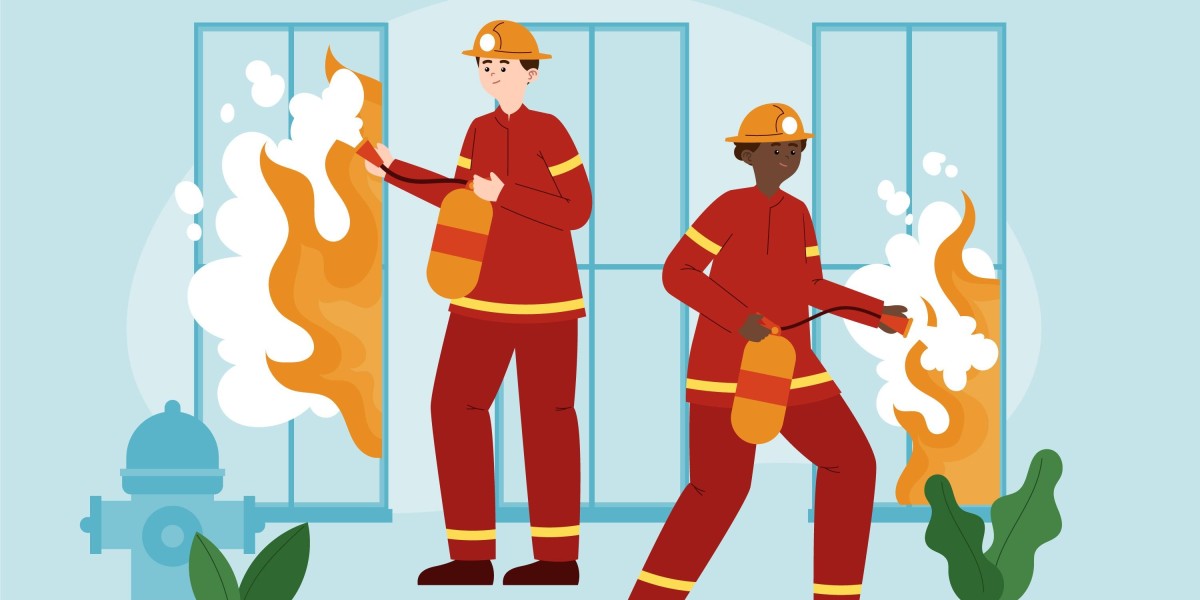Ensuring that a building or facility is safeguarded from fire hazards is critical in today’s world. A well-executed fire safety and risk assessment not only protects property but, more importantly, saves lives. With stringent regulations in place across industries, businesses must prioritize fire safety. In this detailed guide, we’ll walk through the essential steps of conducting a fire safety risk assessment, making sure that you are fully prepared to mitigate fire risks effectively.
By understanding these steps, you will be able to develop a fire safety plan that not only meets regulatory standards but also fosters a safe environment for all occupants. Let’s dive into this comprehensive process to ensure your fire risk assessment is thorough, effective, and optimized for success.
1. Introduction to Fire Safety and Risk Assessment
Fire safety and risk assessment is a systematic process designed to identify fire hazards, assess risks, and develop mitigation strategies. It involves evaluating the likelihood of a fire occurring and determining the potential consequences. Fire risk assessments are mandatory for most businesses, especially those with employees or visitors, and they play a vital role in ensuring the safety of everyone who enters the premises.
The fire safety and risk assessment process begins with understanding the legal requirements in your location. Various laws and regulations require businesses to undertake regular assessments, maintain proper fire safety equipment, and train staff in fire response procedures. Non-compliance can result in hefty fines or worse—an increased likelihood of fire-related incidents.
The primary aim of this assessment is not just about legal compliance but about creating a safe and secure environment where the risk of fire is minimized. This process enables you to identify potential hazards, address weaknesses, and ensure that preventive measures are in place. By conducting regular assessments, you create a proactive safety culture that emphasizes the importance of fire prevention and control.
2. Identifying Fire Hazards: Recognizing Sources of Fire Risk
One of the most important steps in a fire safety risk assessment is identifying fire hazards. These hazards typically come from three key elements: ignition sources, fuel sources, and oxygen.
Ignition sources include anything that can cause a fire, such as electrical equipment, machinery, smoking materials, and heating appliances. Faulty electrical wiring, overloaded circuits, and damaged machinery are common ignition sources that are often overlooked in businesses.
Fuel sources are materials that can burn and help spread a fire. These can range from paper and cardboard in an office environment to flammable chemicals in an industrial setting. Every workplace will have its own unique combination of fuel sources that must be identified and monitored to ensure they don’t contribute to the outbreak of a fire.
Oxygen, the third component of the fire triangle, is often readily available in the atmosphere. In some workplaces, such as medical facilities, the presence of additional oxygen cylinders can exacerbate the risk.
Once you’ve identified these hazards, it's time to evaluate them to understand their potential impact. Consider their proximity to each other and assess how likely it is for these factors to combine and cause a fire. This initial step lays the foundation for a detailed fire risk assessment and allows you to address specific concerns that are unique to your environment.
3. Assessing Fire Risks: Evaluating the Impact on People and Property
After identifying potential hazards, the next step in a fire safety and risk assessment is to assess the level of risk they pose. This involves evaluating the likelihood of a fire occurring and the potential consequences if one were to start. The goal here is to determine who could be at risk and how severe the impact could be on people, property, and the business as a whole.
When evaluating fire risks, it's essential to consider all individuals present on the premises. This includes employees, visitors, contractors, and anyone who may be unfamiliar with the layout of the building. You should also pay special attention to individuals with disabilities, the elderly, or those who may have difficulty evacuating the premises in an emergency.
A fire risk assessment should also account for the potential impact on the building's structure and any valuable equipment or sensitive information stored on-site. For instance, a fire in a data center could result in the loss of critical business information, leading to operational disruptions and financial losses.
Assessing fire risks involves more than just identifying hazards; it requires a deep understanding of how a fire could spread and the effectiveness of the current fire safety measures in place. This process is about determining the level of risk and prioritizing the areas that require immediate attention.
4. Implementing Fire Prevention Measures: Reducing the Likelihood of a Fire
Once the risks have been identified and assessed, the next step is to implement fire prevention measures. These measures are designed to reduce the likelihood of a fire starting and to limit its potential spread. Effective fire prevention strategies revolve around controlling the three elements of fire: heat, fuel, and oxygen.
Begin by addressing ignition sources. Ensure that electrical equipment is regularly inspected and maintained, faulty machinery is repaired promptly, and heating appliances are used safely. Limit the use of open flames, and ensure smoking areas are well away from fuel sources.
Next, manage fuel sources. Store flammable materials in fire-resistant cabinets, dispose of waste materials promptly, and ensure that workspaces are kept tidy and free from excessive clutter that could contribute to the spread of a fire.
Finally, control oxygen supplies. In areas where oxygen is used or stored, such as medical facilities, ensure that oxygen cylinders are kept in secure areas away from potential fire hazards.
Fire prevention also involves ensuring that your building is equipped with the proper fire detection and suppression systems, such as smoke alarms, fire extinguishers, and sprinkler systems. Regularly test and maintain these systems to ensure they are in good working order.
5. Developing a Fire Emergency Plan: Planning for the Worst-Case Scenario
Despite the best prevention efforts, there is always a possibility that a fire could occur. That’s why it’s crucial to develop a comprehensive fire emergency plan as part of your fire safety and risk assessment.
A fire emergency plan outlines the procedures to be followed in the event of a fire, ensuring that everyone knows how to respond. The plan should include clear evacuation routes, assembly points, and instructions on how to use firefighting equipment.
Train employees on how to recognize the sound of the fire alarm and the steps they should take during an emergency. Regular fire drills are essential to ensuring that everyone is familiar with the evacuation procedures and can leave the building quickly and safely.
In addition to the human response, a fire emergency plan should outline the roles of fire wardens or designated fire safety officers. These individuals are responsible for ensuring that all areas of the building are evacuated and that no one is left behind.
The goal of the fire emergency plan is to minimize panic and ensure that everyone knows what to do in the event of a fire. A well-prepared plan can save lives and limit the damage caused by a fire.
6. Installing Fire Safety Equipment: Ensuring Proper Fire Detection and Suppression
Fire detection and suppression equipment play a vital role in reducing the risk of fire-related injuries and property damage. As part of your fire safety and risk assessment, it's essential to ensure that your building is equipped with the appropriate fire safety equipment.
Start with fire detection systems, such as smoke detectors and fire alarms. These devices provide early warning of a fire, allowing occupants to evacuate the building before the fire spreads. Smoke detectors should be installed in all areas of the building, particularly in high-risk areas such as kitchens, electrical rooms, and storage areas.
Fire suppression systems, such as fire extinguishers, sprinkler systems, and fire hoses, are designed to control or extinguish a fire before it grows out of control. Ensure that fire extinguishers are located in easily accessible areas and that employees are trained on how to use them.
In some cases, specialized fire suppression systems, such as gas suppression systems, may be required for specific environments, such as server rooms or chemical storage facilities. These systems release gas to extinguish a fire without causing damage to sensitive equipment.
Regular maintenance and testing of fire safety equipment are critical to ensuring that these systems work effectively in an emergency. Include these tasks in your fire safety plan to ensure that your equipment is always ready when needed.
7. Training and Awareness: Educating Employees on Fire Safety
A key component of any fire safety and risk assessment is ensuring that all employees are educated on fire safety procedures. Proper training ensures that everyone knows how to respond in the event of a fire and how to use fire safety equipment effectively.
Start by providing basic fire safety training to all employees. This training should cover how to recognize fire hazards, the importance of keeping workspaces free from clutter, and the proper use of fire extinguishers and other firefighting equipment.
Fire wardens or safety officers should receive more advanced training, including how to conduct fire safety inspections, oversee evacuation procedures, and use specialized firefighting equipment.
In addition to formal training, raise awareness of fire safety by displaying clear fire safety instructions throughout the building. Signs should indicate the location of fire exits, firefighting equipment, and assembly points.
Regular fire drills are essential to reinforcing fire safety training. Drills allow employees to practice evacuating the building and give them confidence in their ability to respond in an emergency. Make fire safety a core part of your company culture to ensure that everyone takes their responsibility seriously.
8. Reviewing and Updating the Fire Safety and Risk Assessment
Fire safety is an ongoing process, and your fire safety and risk assessment should be regularly reviewed and updated to ensure that it remains effective. Fire risks can change over time as new equipment is installed, building layouts are altered, or new employees join the company.
Conduct regular fire safety inspections to identify new hazards and ensure that fire safety equipment is properly maintained. These inspections should be carried out by trained fire safety officers or external fire safety consultants.
In addition to regular inspections, review your fire emergency plan to ensure that it reflects the current building layout and staffing levels. Update evacuation routes, assembly points, and fire warden responsibilities as needed.
By regularly reviewing and updating your fire safety and risk assessment, you can ensure that your fire prevention and response strategies remain effective. A proactive approach to fire safety will help to protect your employees, property, and business from the devastating effects of fire.
9. The Role of External Fire Safety Consultants in Risk Assessment
For many businesses, especially larger organizations or those operating in high-risk industries, working with an external fire safety consultant can be a valuable part of the fire safety and risk assessment process. Fire safety consultants are experts in identifying fire hazards, assessing risks, and developing comprehensive fire safety plans.
Consultants can bring an unbiased perspective to your fire safety efforts, ensuring that no potential hazards are overlooked. They can also help you navigate complex fire safety regulations and ensure that your business is fully compliant with the latest laws and guidelines.
In addition to conducting fire risk assessments, consultants can provide specialized services such as fire safety training, fire safety system design, and assistance with fire safety audits. Working with a consultant ensures that your fire safety efforts are thorough and that you are fully prepared to prevent and respond to fire-related emergencies.
10. Conclusion: Prioritizing Fire Safety for Long-Term Protection
Conducting a comprehensive fire safety and risk assessment is one of the most important steps you can take to protect your business from the devastating effects of fire. By following the steps outlined in this guide, you can identify fire hazards, assess risks, and implement effective fire prevention and response strategies.
Remember that fire safety is an ongoing process, and regular reviews and updates are essential to ensuring that your fire safety measures remain effective. By prioritizing fire safety, you create a safe and secure environment for your employees, customers, and visitors.
Fire risk assessments not only help you meet legal requirements but also provide peace of mind knowing that you’ve taken every precaution to protect your business and the people within it. Take the first step today by scheduling a comprehensive fire safety risk assessment and investing in the long-term safety of your organization.













